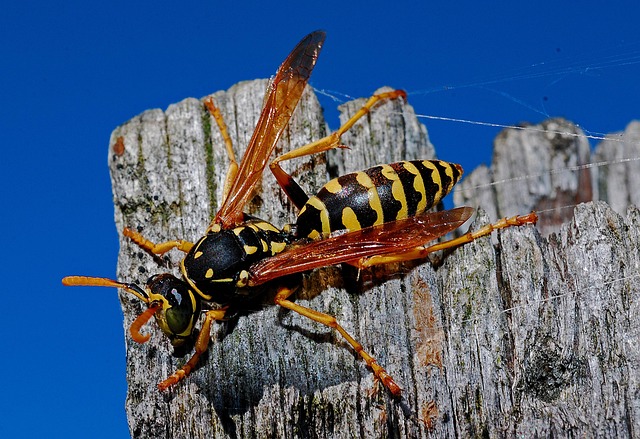Effective professional wasp removal requires understanding wasp social behaviors, including colony structure and communication systems, to locate nests early. Advanced technologies like thermal imaging, remote sensing, and drone surveillance enhance detection and precision. Modern, non-chemical methods such as heat treatment and mechanical traps prioritize safety and minimize environmental impact. Experts use specialized gear, sealing entry points, trapping, and repellents for comprehensive solutions, balancing human safety with ecosystem preservation.
Wasp populations are on the rise, posing significant risks to both human health and local ecosystems. This article explores advanced technologies transforming the landscape of professional wasp removal. From understanding wasp behavior to innovative treatment options, we delve into effective strategies that prioritize safety and environmental well-being. Discover modern tools for nest detection and non-chemical solutions, ensuring a comprehensive approach to managing these stinging pests.
Understanding Wasp Behavior: Key to Effective Professional Wasp Removal
Understanding the behavior and habits of wasps is a critical step in implementing effective strategies for their removal, especially when it comes to professional wasp control. Wasps are social insects with complex communication systems. They live in organized colonies with distinct roles for each member—from queens who lay eggs to workers that forage for food and defend the nest. Recognizing these behaviors allows professionals to tailor their approach.
For instance, identifying nesting sites, such as tree hollows or building voids, is essential. Wasps often choose locations with easy access to prey and suitable temperatures. By locating nests early, pest control experts can employ targeted methods like trapping or applying insecticides directly to the entrance. This behavior-based knowledge enables professionals to humanely and efficiently conduct wasp removal services, ensuring a safer environment for both humans and these intricate creatures.
Advanced Detection Methods: Modern Tools for Locating Nests
Advanced technologies have significantly enhanced the field of pest control, particularly in the realm of wasp detection and removal. Professional wasp removal experts now employ sophisticated methods to locate nests with precision. One such innovation is thermal imaging, which detects heat signatures unique to wasp nests, enabling quick and safe identification. This technology is especially useful in navigating complex environments without disturbing potential colonies.
Additionally, remote sensing and drone surveillance have emerged as powerful tools for professional wasp removal services. Drones equipped with high-resolution cameras can swiftly scan large areas, including hard-to-reach spaces, to pinpoint nests hidden behind structures or within dense vegetation. These modern tools not only increase detection rates but also ensure the safety of technicians by minimizing direct contact with potentially aggressive wasp colonies.
Innovative Treatment Options: From Chemical to Non-Chemical Solutions
In the realm of professional wasp removal, innovative treatment options are transforming the way we address wasp infestations. Beyond traditional chemical sprays, modern solutions offer both safer and more effective methods. Non-chemical alternatives, such as heat treatment and targeted mechanical traps, are gaining traction for their minimal environmental impact and precise targeting of wasps without harming beneficial insects or human health.
These advanced technologies provide a range of benefits, including reduced risk to pets and children, lower environmental toxicity, and the ability to target specific wasp nests with greater accuracy. As such, professional pest control services are increasingly adopting these innovative treatment options, ensuring more effective and sustainable wasp removal for residential and commercial properties alike.
Safety Measures and Prevention: Ensuring Both Human and Environmental Well-being during Wasp Removal
When it comes to dealing with wasps, safety is paramount. Professional wasp removal services are designed to mitigate risks both for the individuals involved and the environment. Experts in this field employ specialized equipment and protective gear to safeguard against stings, which can cause severe reactions in sensitive individuals.
Prevention is another key aspect of professional wasp removal. By identifying and sealing entry points, using traps, and employing repellents, these services aim to eliminate wasps from homes or structures effectively while minimizing the need for repeated treatments. This holistic approach ensures a safe living environment, protects ecosystems by avoiding harmful pesticides, and promotes overall well-being for both humans and wildlife.
In conclusion, understanding wasp behavior is the cornerstone of successful professional wasp removal. Advanced detection methods and innovative treatment options, ranging from chemical to non-chemical solutions, empower experts to address infestations effectively while prioritizing safety and environmental well-being. By combining these cutting-edge technologies with meticulous prevention strategies, professionals ensure swift and safe resolution for both residential and commercial spaces.
